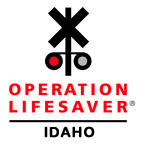
ISP conducting enhance patrols at rail crossings in south-central Idaho
The Idaho State Police will continue to conduct "Adopt a Crossing" an enhanced traffic enforcement operation at railroad crossings in Twin Falls and Jerome counties. The increased patrols began in July and will continue through Sept. 12. The operation was made possible with grant funding provided by the Idaho Department of Transportation's Office of Highway  Safety and Operation Lifesaver.
Safety and Operation Lifesaver.
"The goal of this special enforcement operation is to increase public awareness of the potential dangers that exist at highway railroad intersections and to eliminate driver actions that can have tragic consequences," said Idaho State Police Sgt. Mark Donahue. "It is our hope that by informing the public that we are focusing on enforcing the traffic laws that pertain to these rail crossings that they always be more careful when approaching them."
The "Adopt a Crossing" enforcement operation will pick a rail crossing within their jurisdiction and focus on enforcing the laws that pertain to that crossing.
Thus far in 2015, there have been four vehicle/train collisions in Idaho. In 2014, there were 20 vehicle/train collisions resulting in one fatality along with two pedestrians who were killed while on train tracks.
Troopers remind drivers that they can avoid a citation, and more importantly injuries or death, by following these safety tips:
-
Stay alert around railroad tracks. No texting, headphones or other distractions that would prevent you from hearing an approaching train; never mix rails and recreation.
-
Always expect a train at each highway-rail intersection. Freight trains don't travel at fixed times, and schedules for passenger trains change.
-
All train tracks are private property. Never walk on tracks; it's illegal to trespass and highly dangerous. By the time a locomotive engineer sees a trespasser or vehicle on the tracks it's too late. It takes the average freight train traveling at 55 mph more than a mile -- the length of 18 football fields -- to stop. Trains cannot stop quickly enough to avoid a collision.
-
The average locomotive weighs about 400,000 pounds or 200 tons; it can weigh up to 6,000 tons. This makes the weight ratio of a car to a train proportional to that of a soda can to a car. We all know what happens to a soda can hit by a car.
-
Trains have the right of way 100 percent of the time over all pedestrians and vehicles, even emergency vehicles.
-
A train can extend three feet or more beyond the steel rail, putting the safety zone for pedestrians well beyond the three foot mark. If there are rails on the railroad ties always assume the track is in use, even if there are weeds or the track looks unused.
-
Trains can move in either direction at any time. Sometimes their cars are pushed by locomotives instead of being pulled.
-
Today's trains are quieter than ever, producing no telltale "clackety-clack." Any approaching train is always closer, moving faster, than you think. Remember to cross train tracks only at designated pedestrian or roadway crossings, and obey all warning signs and signals posted there.
For more than 25 years, the Idaho State Police and Idaho Operation Lifesaver have partnered to eliminate car versus train collisions, which result in preventable deaths and injuries.
Published 08-21-15